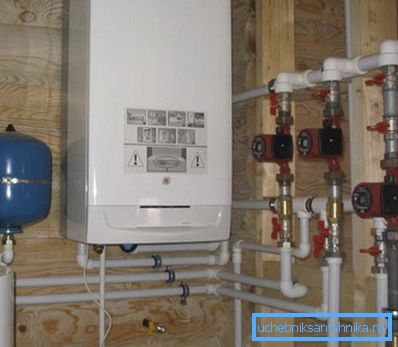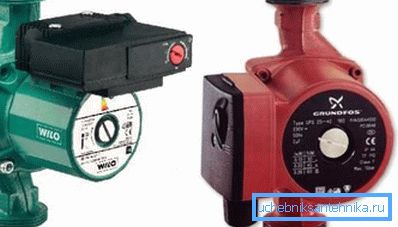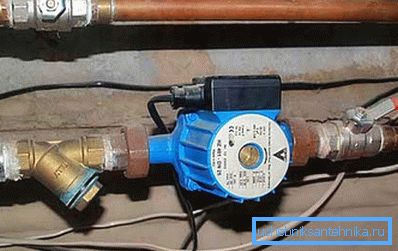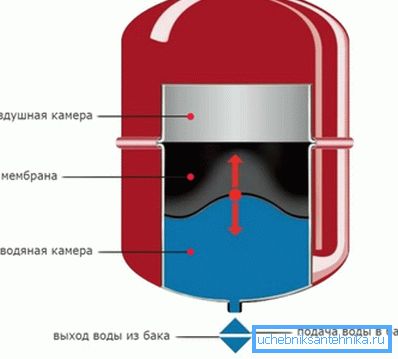Heating system with forced circulation in a private house:
How can a heating system be installed with forced circulation with your own hands? What questions and problems may arise at different stages of work? How to choose a pump with the required capacity and pipes of optimal diameter? In the article we will try to answer these questions.

Choice of pipes and radiators
We'll start by choosing materials, batteries, and pipeline sizes.
Materials
Water heating with forced circulation implies an autonomous circuit, in no way connected with the centralized mains.
It should be clarified: usually the circuit is connected to the cold-water system with a jumper to fill it with water. However, after the coolant is filled, the jumper is securely closed.
If so - the heating parameters are predictable, stable and safe even for the most vulnerable modern materials:
- The pressure in the circuit is kept within 1.5-2.5 kgf / cm2.
- Typical temperatures of supply and return pipelines are 70/50 C.
The best choice for the heating system is polypropylene, reinforced with aluminum foil. Reinforcement is necessary not so much from considerations of strength, but because it compensates for the high coefficient of linear expansion of polypropylene during heating. (See also the article Polypropylene Tubes: Features.)
The heating device, optimum for our purposes, - an aluminum section radiator.
The reasons?
- It is a decent appearance, consistent with any room design.

- Reasonable price (from 300 rubles per section).
- High heat dissipation (approximately 200 watts per section with 500 mm nipple center distance).
Dimensions
The reasonable minimum of the internal diameter of pipes of any type is:
| Contour plot | Inner diameter |
| Radiator outlet | 15 mm |
| Filling up to 50 m | 20 mm |
| Filling over 50 m | 25 mm |
Please note: polypropylene is marked with an outer diameter, which is about 5-7 mm larger than the inner diameter. The specified internal diameters correspond to the dimensions of 20, 25 and 32 mm.
Pump
Selection
What should be a pump for a heating system with forced circulation? The obvious choice is a device with a wet rotor, low-speed and allowable performance adjustment (step or smooth). (See also the article Single-pipe heating system: features.)

The main two parameters of any pump are the pressure created by it and its performance at the hydraulic resistance of the circuit corresponding to this pressure.
What values should be stopped?
- Maximum hydraulic resistance of a circuit of reasonable length - 1-2 meters. Accordingly, for a private house (if, of course, you do not build a palace in which you will host international conferences), a pressure of 4 meters, typical of the younger devices of all famous manufacturers, is enough.
- Capacity is selected so that the entire coolant in the circuit passes through the pump in about 20 minutes. (that is, the pump capacity in cubic meters per hour is equal to three times the volume of the coolant).
To calculate the performance, there is also an alternative scheme tied to the heat output of the boiler or circuit section.
It reduces to a formula of the form G = Q / (1.163 * Dt), in which:
- G - the desired performance in cubic meters per hour.
- Q is the heat output of the boiler or circuit in kilowatts.
- 1.163 - the average heat capacity of water.
- Dt is the delta temperature between the flow and the return pipe. At standard values of 70/50, it is easy to calculate, it is equal to 20.
So, with a boiler power of 36 kW, the reasonable minimum performance will be 36 / (1.163 * 20) = 1.55 m3 / hour.
Installation
How to install a pump with your hands in a forced heating of the house?
In general, there are not too many rules here.
- A wet rotor pump is mounted with a strictly horizontal shaft position.

- Since the function of cooling the motor and lubricating the bearings is placed on the coolant, the pump is extremely sensitive to its quality. From here - one more urgent recommendation: a heating circuit with forced circulation should include a sump (in the simplest version - a coarse filter), which is mounted directly in front of the pump.
- The pump and filter are cut off from the rest of the circuit with a pair of valves that will allow cleaning the sump or removing the pump with minimal loss of heat transfer medium.
- When the pump is installed in a circuit that periodically operates with natural circulation, a bypass with a diameter equal to the filling diameter is left between the tie-ins to the pump. The bypass is equipped with a ball check valve or valve.
Optional equipment
In addition to the mud pump, the forced heating system must include:
- Expansion tank. It is placed at any point of the contour where there is no turbulence. The volume of the tank should be approximately equal to 10% of the volume of the circuit.

- Pressure relief valve to prevent pipe rupture when the expansion tank overflows.
- Pressure gauge for pressure control.
- Automatic air vent.
- Air vent (Mayevsky cranes or conventional valves) in the upper points of the circuit (including in traffic jams of radiators with a lower connection).
Scheme
It is clear that the specific scheme of the heating system with forced circulation is determined primarily by the configuration of the house. We will give, however, as examples a couple of popular solutions.

In this diagram:
| room | Device |
| one | Boiler |
| 2 | Discharge into the sewer in case of tank overflow |
| 3 | Open expansion tank |
| four | Pump |
| five | Reset for draining the circuit |
| 6 | Filling (feed) |
| 7 | Cranes Mayevsky |
| eight | Radiators |
| 9 | Filling (return) |
| ten | Sewage |
| eleven | The valve on the jumper with cold water |
| 12 | Cold-water system |
| 13 (a) | Radiator shut-off valves |
| 14 | Bypasses between radiator inserts |

This scheme is interesting because it allows to form an additional low-temperature circuit. To reduce the temperature, a metered supply of water from a straight line through a thermostat and recirculation of the return flow is used.
Conclusion
We hope that the material proposed to the reader will help him in designing his own heating system. In the attached video, as usual, you can find additional information. Successes!